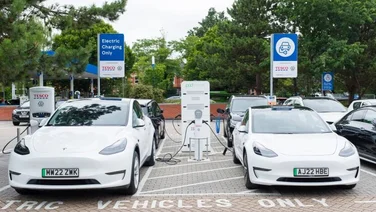- The top three greenest countries are Denmark, the UK, and Finland
- Denmark aims to reduce emissions by 70% by 2030
- The UK is aiming to reduce emissions by 68% by 2030
The greenest countries in the world have worked hard to get that recognition.
A lot of factors influence how a country is ranked by ‘greenness’. This includes their current and future emissions, as well as their environmental policies, the quality of their air and water, and the health of their ecosystems.
With this in mind, we’ve settled on using the ranking provided by Yale University’s Environmental Performance Index. We’ll take a look at how each country has earned its spot on our top 11 greenest countries list.

What are the greenest countries in the world?
This ranking is based on results from the most recent Environmental Performance Index (EPI), compiled by Yale’s Centre for Environmental Law and Policy.
The EPI awards scores to countries based on 40 key indicators, which include environmental policy, projected greenhouse gas (GHG) emissions, air and water quality, and biodiversity.
The average global environmental score is 60, 1 is the lowest possible score, and 100 is the ideal. All the top 11 countries have a score higher than 65. Let’s look at how they managed that.
1. Estonia
Estonia takes the top spot for the greenest country in 2024, with an environmental performance score of 75.7.
In early 2021, the Estonian government announced plans to reach carbon neutrality by 2025 to stop producing shale oil in 2035.
Currently, more than half (51%) of Estonia is covered by forest and is up from 10th place from 2022. This makes it the sixth most forested nation in Europe.
The country also has a unique energy mix, with its energy supply dominated by domestically produced oil shale, giving the country a high degree of energy independence and carbon neutrality.
The World Health Organisation also ranked Estonia’s air as some of the cleanest air in the world, along with countries, like Finland and Iceland.
2. Luxembourg
The small, landlocked nation of Luxembourg was awarded second place, at 75.1. This is up from sixth position in 2022.
Among this, the country ranked higher for its Ecosystem Vitality, which was awarded a score of 83.1.
Luxembourg’s most well-known environmental achievement is the Luxembourg Green Exchange. The sustainable finance platform encourages investments into green causes and companies.
In terms of protecting local ecosystems, around 55% of land in Luxembourg is defined as a protected area (an area designated for nature conservation). This is much higher than the EU target of 30% protected area coverage by 2030.

Get free solar panel quotes
Answer a few quick questions, and our trusted installers will send you bespoke solar panel quotes – for free.
3. Germany
Germany is ranked fourth, with a total score of 74.5.
The country plans to reach climate neutrality by 2045 and negative emissions by 2050. This was recorded when the government passed its Climate Protection Act in 2019 and updated in 2021.
Back in 2022, Germany closed its last nuclear power plant, and any gaps in power production were filled with renewables, gas turbines and conversation.
It also launched The Renewable Heat Act, which aimed to increase renewable heating sources to 14% by 2020.
4. Finland
Finland is fourth, with a total score of 73.58. This is a point lower than previous years, though.
Two categories largely contribute to this ranking. Firstly, it came third in the Climate Change Mitigation category.
Emissions in Finland are decreasing year on year, falling by 22% between 2005 and 2019. Finland is decarbonising domestic heating and is among the top countries for heat pump installations, with 24,159 heat pumps per 100,000 people.
Finland also ranks second in the Environmental Health’ category. This measures how well a country protects the health of its population through the lens of air and water quality, and waste management.
According to statistics from the World Health Organisation (WHO), Finland has some of the cleanest air in the world, with the concentration of fine particulate matter at 6mg per cubic metre on average. This is well below the WHO requirement of 10mg per cubic metre.
For context, in UK cities, the concentration of fine particulate matter regularly goes above 40 mg per cubic metre.

5. UK
The UK has a score of 72.6 in the 2024 rankings, which might be surprising to some.
The country have been encouraging renewable tech for years now, as part of its aim to achieve Net Zero by 2050. This includes heat pumps, solar panels and electric vehicles.
As part of this, it has introduced many schemes to encourage uptake, such as the Boiler Upgrade Scheme (BUS), the Warm Homes Local Grant, as well as government grants for solar panels.
Between 2021 and 2022, CO2 emissions the UK did experience a decline of 2.4%. Although this was due to warmer weather conditions and the energy crisis leading to fewer people using their heating.

Get £7500 towards your heat pump installation through a trusted installer
An MCS-certified heat pump installer can apply for the Boiler Upgrade Scheme on your behalf, get a quote from one now
6. Sweden
Sweden is ranked sixth, with a score of 70.3.
Sweden’s GHG emissions have been on the decline, going from 7.87 tonnes per capita in 2016 to 6.22 tonnes in 2021. This was helped by the fact that over 60% of Sweden’s energy comes from renewable sources.
Sweden also has relatively good air quality, with a concentration of fine particulate matter that’s regularly below the WHO recommendation. In 2019 for example, fine particulate matter was at 6.1mg per cubic metre.
7. Norway
Norway has ranked seventh in the 2024 report, with a score of 69.9.
To name a few of the sustainable initiatives they’ve done, Norway has built more than 330 damns and runs mostly on clean hydropower.
It has also made significant progress in electrifying its transportation, with Oslo leading the charge. It has the most electric vehicles per capita of any major city in the world.
Norway even promotes eco-friendly travel opportunities, including local food, environmentally certified tour operators and sustainable destinations.
This is all part of their goal to become carbon neutral by 2030.
8. Austria
Austria takes eighth place for environmental performance, with a score of 68.9.
Around half of Austria’s natural sites hold protected status. This includes four UNESCO biosphere reserves, which are nature sites dedicated to research into sustainable development.
The water quality of the country’s natural lakes and rivers is also the second best in Europe, behind Cyprus.
Austria loses out on a higher spot because it’s lagging behind the EU when it comes to reducing emissions. A 2021 EU report noted it seemed “unlikely” Austria would achieve its goal of reducing emissions by 36% by 2030.
9. Switzerland
In ninth place for environmental performance is Switzerland, with a total score of 67.8.
Around 52% of all waste in Switzerland is recycled – one of the highest rates in the world. All remaining waste is incinerated to produce electricity and heat, a process that fulfils around 2% of the country’s energy needs.
Additionally, there are strict regulations around the handling of hazardous waste and waste destined for landfill. Almost one-third of hazardous waste is recycled, and the rest undergoes special treatment to ensure it doesn’t contaminate the environment.
10. Denmark
Denmark takes the tenth spot for the greenest country, with an environmental performance score of 67.7.
Denmark has ambitious goals when it comes to shrinking its carbon footprint. The country aims to reduce GHG emissions by 50-54% by 2025 compared to 1990s levels, and 70% by 2030.
Denmark already managed to cut its emissions by 23% between 2005 and 2018, and the intensity of its carbon emissions is 43 % below the European Union (EU) average.
The 2025 EPI ranking is yet to be released, but we will update this page when it is.
Summary
- The EPI ranking is a good place to start when it comes to assessing how far along countries are on their journey to protecting the environment
- The EPI itself admits there are data gaps, especially when it comes to scoring “agriculture, water resources, and threats to biodiversity.”
- This list is more of a measure of the environmental progress made by countries, rather than a measure of how ‘green’ they actually are
- Estonia is in the top spot, followed by Luxembourg
- Denmark is tenth with a ranking of 67.7

Get free solar panel quotes
Answer a few quick questions, and our trusted installers will send you bespoke solar panel quotes – for free.







